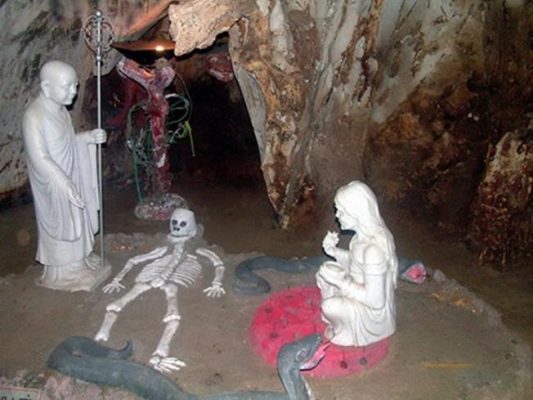
Entrance to hell – Am Phu Cave
Dive into the depths of Am Phu Cave, a spiritual sanctuary in Da Nang’s Marble Mountains. Marvel at ancient Buddhist statues, stalactites, and the cave’s historical significance. Discover why Am Phu Cave is a must-see attraction for travelers seeking cultural immersion in Vietnam. Start your experience journey with Ula Travel today!
I. Introduction to Am Phu Cave
1. Where is Am Phu Cave?
Am Phu Cave, known as the Cave of Hell, is situated within the Marble Mountains. These mountains are named after the five elements: metal, wood, water, fire, and earth. Am Phu Cave, located in Water Mountain, is one of the most visited caves in this area, drawing tourists with its mysterious allure and historical importance.
2. What is Interesting about Am Phu Cave?
Am Phu Cave offers a captivating blend of natural beauty, adventure, and cultural enrichment. Visitors can explore the cave’s intricate network of tunnels and chambers, adorned with stalactites, stalagmites, and impressive statues depicting scenes from Buddhist hell. These elements provide a vivid representation of the afterlife, according to Vietnamese Buddhist beliefs.

The mysterious beauty inside Am Phu cave
The cave’s atmosphere, with its dim lighting and eerie echoes, creates an unforgettable experience, immersing visitors in the spiritual and historical narratives of the region. Moreover, the Marble Mountains themselves offer panoramic views of the surrounding landscape, making Am Phu Cave a perfect starting point for a broader exploration of Da Nang’s natural and cultural heritage.
3. What to Expect When Visiting Am Phu Cave
Am Phu Cave offers a captivating and mystical experience, combining natural beauty with spiritual significance. As you enter the cave, you’ll be greeted by a dramatic landscape of stalactites and stalagmites, illuminated by soft lighting that enhances the ethereal atmosphere. The cave is filled with religious sculptures and altars, creating a sense of reverence and wonder.

The simulation of hell and the philosophy of Buddhism
Inside, you will find various chambers and pathways, each with its own unique features. The cave’s main attraction is its representation of the Buddhist concept of hell, with depictions of various levels of suffering and enlightenment. This stark imagery is intended to remind visitors of the consequences of their actions and the importance of leading a virtuous life.
Are you looking for: Da Nang tours
II. History of Am Phu Cave
1. Myths and Legends Associated with the Cave
Am Phu Cave is steeped in myth and legend, adding to its allure and mystique. According to local lore, the cave represents the afterlife journey, divided into various levels of hell and heaven. This depiction is meant to mirror the Buddhist belief in karma and the cycles of rebirth. Visitors encounter sculptures and carvings illustrating the punishments for sins and the rewards for good deeds, emphasizing the moral teachings central to Buddhism.
2. Historical Role of Am Phu Cave
Throughout its history, Am Phu Cave has been a site of both spiritual pilgrimage and historical significance. During the Vietnam War, the Marble Mountains, including Am Phu Cave, served as a strategic location due to their natural concealment. The cave provided shelter and a base for the Viet Cong, making it a site of tactical importance. Artifacts and remnants from this period have been discovered, providing a glimpse into the wartime history of the area.

Ancient stone stele inside Am Phu cave
Notably, the cave is also home to several ancient inscriptions and statues that date back centuries, showcasing the long-standing cultural and religious significance of the site. These historical artifacts offer valuable insights into the artistic and spiritual practices of the region’s ancestors.
III. Cultural Significance of Am Phu Cave
1. The Role of Am Phu Cave in Vietnamese Culture and Religion
Am Phu Cave holds a profound place in Vietnamese culture and religious practices. The name “Am Phu” translates to “Hell,” reflecting the cave’s role as a symbolic representation of the afterlife in Buddhist cosmology.

Religious beliefs are clearly expressed through stone statues
This cave is designed to depict the journey of souls through various stages of purgatory, showcasing both the punishments for sins and the rewards for good deeds. The cave serves as a vivid reminder of the moral teachings prevalent in Vietnamese society, emphasizing the importance of leading a virtuous life.
Pilgrims visit to offer prayers, make offerings, and reflect on their lives in light of Buddhist teachings. This makes Am Phu Cave not only a tourist attraction but also a living, breathing part of Vietnam’s spiritual landscape.
Do not miss: Da Nang to Hue – Unexpected Trip You’ll Love
2. Significance in Buddhism and Local Traditions

Buddhist philosophy is expressed throughout the cave
In Buddhism, the concept of hell is not eternal but a place where souls are purified before reincarnation. Am Phu Cave vividly illustrates this concept with its intricate carvings and statues that depict the various hellish realms and the punishments meted out to sinners. This depiction serves as a didactic tool, educating visitors about the consequences of their actions and the karmic cycle of rebirth.
The cave’s layout and design draw heavily from Buddhist teachings and iconography. Visitors are greeted by the imposing statues of the guardians of hell, which are meant to instill a sense of reverence and reflection.
As they venture deeper into the cave, they encounter scenes of judgment, punishment, and eventual redemption. These scenes are not only visually striking but also serve as moral lessons deeply embedded in local traditions and beliefs.
3. Famous Sculptures and Religious Artifacts inside the Cave

The meticulously carved stone statues are very impressive
Am Phu Cave is renowned for its impressive array of sculptures and religious artifacts, each with its own unique story and significance. One of the most striking features is the statue of the Buddha at the entrance, symbolizing the light of wisdom and compassion that guides all beings. This statue sets the tone for the journey through the cave, reminding visitors of the ultimate goal of enlightenment.
Deeper inside the cave, visitors will find a series of detailed carvings and statues that portray various scenes from Buddhist hell. These include depictions of sinners undergoing punishments such as boiling in cauldrons, being pierced by spears, and other graphic imagery meant to convey the seriousness of moral transgressions. These sculptures are masterfully crafted, with an attention to detail that brings the ancient stories to life.
In addition to the statues, the cave houses numerous altars and shrines where visitors can pause to offer prayers and incense. These religious artifacts are often adorned with traditional Vietnamese motifs and inscriptions, adding to the cave’s rich cultural tapestry.
IV. Experiences at Am Phu Cave
1. The Special Structure – the Road Leading to Hell
Am Phu Cave is a fascinating and intricate cave located in the Marble Mountains. The cave is renowned for its complex and captivating structure, offering visitors a unique experience as they traverse its winding pathways and chambers.

The path seems to lead visitors to a mysterious hell
Upon entering the cave, visitors are greeted by a series of steep steps that lead down into the depths of the cave. The descent is both thrilling and slightly eerie, setting the tone for the rest of the exploration. The cave is expansive, with numerous chambers and passageways that vary in size and shape, creating a labyrinthine experience.
The lighting within the cave is strategically placed to enhance the natural beauty of the rock formations while also illuminating the various statues and altars that adorn the interior. The combination of natural light filtering through openings and artificial lighting creates an otherworldly atmosphere, making the cave both mysterious and awe-inspiring.
Start your journey with: Da Nang to Hoi An in 4 Days
2. Admire Nature’s Masterpieces

The grandeur inside Am Phu cave
Over centuries, Am Phu Cave has been shaped by natural forces, resulting in stunning stalactites and stalagmites that adorn the ceilings and floors of the chambers. These formations vary in size and shape, with some resembling intricate chandeliers while others take on more abstract forms.
In addition to the stalactites and stalagmites, Am Phu Cave also features other unique geological formations such as flowstones. These formations add to the visual spectacle of the cave, making it a geological wonder and a testament to the natural beauty of Vietnam’s underground landscapes.
You will be like: Discover Central Vietnam Tour in 6 Days
3. Unique Spots inside Am Phu Cave

A large and majestic Buddha statue in the middle of the cave
One of the key attractions within the cave is the large statue of the Buddha seated in meditation. This statue is centrally located within one of the main chambers and serves as a focal point for visitors. The serene expression of the Buddha, combined with the tranquil surroundings, creates a peaceful and reflective atmosphere.

Buddha statues inside the cave
Another significant feature is the collection of statues depicting various deities and figures from Buddhist mythology. These statues are intricately carved and placed at strategic points within the cave, each representing different aspects of the Buddhist cosmology. Visitors can explore these statues and learn about the stories and teachings they represent.

There are many worship areas inside the cave
In addition to the statues, Am Phu Cave also contains several altars where visitors can offer prayers and incense. These altars are adorned with offerings and decorations, creating a vibrant and colorful contrast to the natural stone surroundings.

Ancient inscriptions on cliffs
Inscriptions and carvings on the cave walls provide further insight into the historical and religious significance of Am Phu Cave. These inscriptions, some of which date back centuries, offer a glimpse into the beliefs and practices of the people who have visited and worshiped in the cave over the years.
More details: Central Vietnam Wonders Tour
V. Useful Information for Tourists
1. Best Time to Visit Am Phu Cave
Best Seasons to Visit:
- Spring (March to May): Spring is one of the best times to visit Am Phu Cave. The weather is mild and comfortable, with temperatures ranging from 20°C to 30°C (68°F to 86°F). This season offers clear skies and blooming flowers, making it an ideal time for outdoor activities and exploration.
- Autumn (September to November): Autumn is another excellent season to visit. The weather is pleasant, with temperatures similar to spring. The humidity levels drop, and the landscapes are often lush and green after the summer rains, providing picturesque views and a refreshing atmosphere.
Times of Day:
- Morning (8 AM to 11 AM): Visiting Am Phu Cave in the morning is highly recommended. The temperature is cooler, and the lighting inside the cave is optimal for viewing the intricate details of the sculptures and formations. Additionally, there are usually fewer tourists in the morning, allowing for a more peaceful and immersive experience.
- Late Afternoon (3 PM to 5 PM): The late afternoon is another good time to visit. The weather remains comfortable, and the cave is less crowded compared to midday. The lighting during this time can create a dramatic effect on the cave’s interior, enhancing the mystical ambiance.
2. Entry Fees and Opening Hours
Entry Fees:
Because the ticket price to visit Am Phu Cave is not included in the ticket price to visit the Marble Mountains scenic complex, visitors will need to buy a separate ticket to visit this cave. Specific ticket prices are as follows:
- Adults: 20,000 VND/person
- Students: 7,000 VND/person
- Children under 6 years old: Free
Opening Hours:
- Marble Mountains and Am Phu Cave are open daily from 7:00 AM to 5:30 PM.
- It’s advisable to arrive early to avoid crowds and enjoy a more serene experience.
3. Travel Tips for Visiting Am Phu Cave
While Am Phu Cave is a relatively safe and accessible destination, there are a few considerations to keep in mind to ensure a smooth visit:
- Footwear: Wear comfortable and sturdy shoes, as the cave floor can be uneven and slippery in some places. Good grip is essential for navigating the stairs and pathways.
- Lighting: Although the cave is well-lit, bringing a small flashlight or using your phone’s torch can be helpful for exploring darker corners and for extra safety.
- Physical Fitness: The cave involves some stair climbing and walking on uneven terrain. Visitors with mobility issues or health concerns should assess their ability to navigate these challenges.
- Hydration and Snacks: Bring a water bottle and some light snacks, especially if you plan to spend an extended period exploring the cave. There may not be vendors inside the cave, so it’s best to come prepared.
- Respectful Behavior: Remember that Am Phu Cave is a sacred site for many locals. Maintain a respectful demeanor, avoid loud conversations, and be mindful of the cultural
VI. Nearby Attractions
1. Marble Mountains

Marble Mountains
The Marble Mountains are a cluster of five marble and limestone hills located in close proximity to Am Phu Cave. Each mountain is named after one of the five elements: Kim (metal), Thuy (water), Moc (wood), Hoa (fire), and Tho (earth). These mountains are home to numerous caves, tunnels, and Buddhist sanctuaries, offering a rich cultural and spiritual experience.
Highlights:
- Thuy Son is the largest and most famous mountain, featuring several pagodas, caves, and stunning viewpoints.
- Huyen Khong Cave: Known for its large, open chamber and spiritual atmosphere, it is often used for meditation and religious ceremonies.
- Tam Thai Pagoda: a historic pagoda with intricate architecture, offering a peaceful retreat and panoramic views of the surrounding area.
2. Non Nuoc Stone Carving Village

Non Nuoc Stone Carving Village
Located at the foot of the Marble Mountains, Non Nuoc Stone Carving Village is renowned for its skilled artisans, who have been crafting marble sculptures for centuries. Visitors can observe the craftsmen at work and purchase unique, handcrafted souvenirs.
Highlights:
- Artisan Workshops: Watch the detailed process of marble carving and see various stages of sculpture creation.
- Showrooms: Explore a wide range of marble products, from small figurines to large statues, all available for purchase.
- Cultural Heritage: Learn about the history and significance of stone carving in the local culture.
Click here: Central Vietnam Wonders Tour
3. My Khe Beach

My Khe Beach
Just a short drive from Am Phu Cave, My Khe Beach is one of the most famous beaches in Da Nang. Known for its fine white sand, gentle waves, and clear blue water, it’s an ideal spot for relaxation and water activities.
Highlights:
- Water Sports: Enjoy activities like swimming, surfing, jet-skiing, and paddleboarding.
- Beachfront Cafes: Relax at one of the many cafes and restaurants along the beach, offering fresh seafood and refreshing drinks.
- Sunset Views: Experience breathtaking sunsets over the East Sea, perfect for a romantic evening or a peaceful end to the day.
4. Da Nang City Center

Da Nang City Center
Da Nang is a vibrant area with a mix of modern and traditional attractions. From bustling markets to contemporary landmarks, there’s plenty to explore.
Highlights:
- Dragon Bridge: An iconic symbol of Da Nang, this impressive bridge features a dragon design and spectacular fire and water shows on weekends.
- Han Market: A bustling market offering a wide variety of local products, including fresh produce, souvenirs, and clothing.
- Cham Museum: Home to the largest collection of Cham artifacts in the world, providing insight into the ancient Cham civilization that once flourished in the region.
5. Hoi An Ancient Town

Hoi An Ancient Town
Hoi An, a UNESCO World Heritage Site, is a charming ancient town located about 30 kilometers south of Da Nang. Known for its well-preserved architecture, historic streets, and vibrant lanterns, Hoi An Ancient Town offers a glimpse into Vietnam’s rich cultural heritage.
Highlights:
- Japanese Covered Bridge: An iconic symbol of Hoi An, this historic bridge dates back to the 18th century and features intricate carvings and a small temple.
- Hoi An Night Market: A lively market with a variety of food stalls, handicrafts, and colorful lanterns, creating a festive atmosphere every evening.
- Old Town: Wander through the narrow streets lined with ancient houses, traditional shops, and charming cafes, each telling a story of Hoi An’s past.
In conclusion, Am Phu Cave stands as a profound testament to Vietnam’s cultural and spiritual heritage. This sacred site offers visitors a glimpse into the country’s rich Buddhist traditions and geological wonders. Whether you’re drawn by its historical allure or seeking a deeper cultural experience, Am Phu Cave promises an unforgettable journey into Vietnam’s vibrant past and natural beauty. Plan your visit today and embark on an exploration that transcends time and tradition.
See more: Da Nang travel tips



























